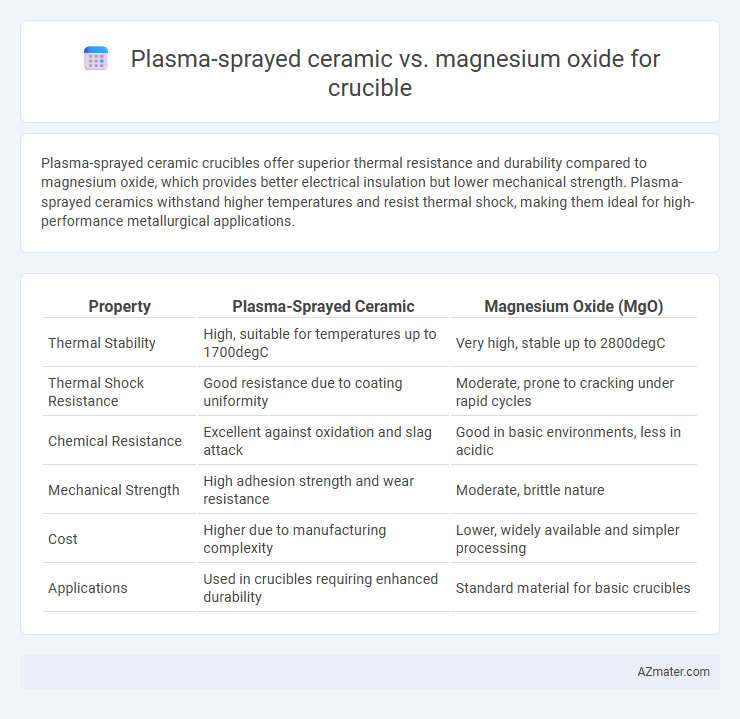Plasma-sprayed ceramic crucibles offer superior thermal resistance and durability compared to magnesium oxide, which provides better electrical insulation but lower mechanical strength. Plasma-sprayed ceramics withstand higher temperatures and resist thermal shock, making them ideal for high-performance metallurgical applications.
Table of Comparison
| Property | Plasma-Sprayed Ceramic | Magnesium Oxide (MgO) |
|---|---|---|
| Thermal Stability | High, suitable for temperatures up to 1700degC | Very high, stable up to 2800degC |
| Thermal Shock Resistance | Good resistance due to coating uniformity | Moderate, prone to cracking under rapid cycles |
| Chemical Resistance | Excellent against oxidation and slag attack | Good in basic environments, less in acidic |
| Mechanical Strength | High adhesion strength and wear resistance | Moderate, brittle nature |
| Cost | Higher due to manufacturing complexity | Lower, widely available and simpler processing |
| Applications | Used in crucibles requiring enhanced durability | Standard material for basic crucibles |
Introduction to Crucible Materials
Crucible materials must withstand extreme temperatures and thermal shock during metal melting and casting processes. Plasma-sprayed ceramics provide superior thermal barrier properties and high wear resistance compared to traditional magnesium oxide, which offers good thermal conductivity but lower mechanical strength. The choice between plasma-sprayed ceramics and magnesium oxide depends on specific application requirements such as temperature tolerance, chemical stability, and cost efficiency.
Overview of Plasma-Sprayed Ceramic Crucibles
Plasma-sprayed ceramic crucibles offer enhanced thermal resistance and chemical stability compared to traditional magnesium oxide crucibles, making them ideal for high-temperature applications in metallurgy and material science. The plasma-spraying process deposits a dense, uniform ceramic coating that improves durability and reduces contamination risks during metal melting or casting. These crucibles provide superior performance in environments requiring rapid heating and cooling cycles, with a longer service life under extreme thermal stress.
Key Properties of Magnesium Oxide Crucibles
Magnesium oxide crucibles offer excellent thermal conductivity, high melting points above 2800degC, and outstanding resistance to chemical corrosion and slag penetration, making them ideal for high-temperature melting and metallurgical processes. Their refractoriness and mechanical strength ensure durability under thermal shock and repeated heating cycles, outperforming plasma-sprayed ceramic coatings in longevity. The inherent purity and non-wetting properties of magnesium oxide reduce contamination risks during metal casting, ensuring superior material integrity.
Thermal Stability Comparison
Plasma-sprayed ceramic crucibles exhibit superior thermal stability with resistance to high temperatures up to 1800degC and excellent thermal shock resistance, making them ideal for extreme thermal environments. Magnesium oxide crucibles, while capable of withstanding temperatures around 2800degC, tend to have lower thermal shock resistance and can suffer from structural degradation during rapid temperature changes. The choice depends on application requirements, where plasma-sprayed ceramics excel in consistent heat cycling and magnesium oxide favors highest temperature endurance.
Chemical Resistance and Reactivity
Plasma-sprayed ceramic coatings on crucibles exhibit superior chemical resistance compared to magnesium oxide, effectively withstanding corrosive environments and molten metals without significant degradation. Magnesium oxide, while thermally stable and refractory, tends to react with certain slags and fluxes, leading to gradual erosion and contamination during high-temperature processes. The enhanced inertness of plasma-sprayed ceramics reduces chemical reactivity, improving crucible lifespan and purity of processed materials in metallurgical applications.
Mechanical Strength and Durability
Plasma-sprayed ceramic coatings exhibit superior mechanical strength and enhanced durability compared to magnesium oxide crucibles, owing to their dense microstructure and strong adhesion to the substrate. Magnesium oxide, while possessing good thermal stability, tends to have lower fracture toughness and is more prone to degradation under thermal cycling and mechanical stress. The advanced wear resistance and reduced crack propagation in plasma-sprayed ceramics make them ideal for high-stress applications requiring prolonged service life.
Performance in High-Temperature Applications
Plasma-sprayed ceramic coatings offer superior thermal resistance and erosion protection compared to magnesium oxide in crucibles, maintaining structural integrity at temperatures exceeding 1500degC. Magnesium oxide, while thermally stable up to around 2800degC, is prone to rapid degradation and sintering under cyclic thermal stress, reducing its lifespan in high-temperature environments. The enhanced durability and corrosion resistance of plasma-sprayed ceramics make them ideal for applications requiring prolonged exposure to extreme heat and aggressive molten materials.
Cost-Effectiveness and Availability
Plasma-sprayed ceramic crucibles offer high durability and thermal resistance but come with a higher initial cost compared to magnesium oxide (MgO) crucibles. Magnesium oxide crucibles are widely available and cost-effective, making them suitable for general laboratory use despite their lower thermal shock resistance. MgO's abundance and affordability provide a practical advantage for operations prioritizing budget and ease of replacement over maximum performance.
Use Cases in Industry and Research
Plasma-sprayed ceramic coatings provide superior thermal insulation, high wear resistance, and chemical inertness, making them ideal for high-temperature applications in aerospace and nuclear industry crucibles. Magnesium oxide crucibles excel in metallurgical processes and crystal growth research due to their high melting point, excellent thermal conductivity, and resistance to chemical attack from molten metals. Both materials support advanced industrial and scientific use cases by enhancing durability, thermal performance, and contamination prevention in extreme environments.
Conclusion: Choosing the Right Crucible Material
Plasma-sprayed ceramic crucibles offer superior thermal resistance and chemical stability, making them ideal for high-temperature applications requiring durability and minimal contamination. Magnesium oxide crucibles provide excellent thermal conductivity and cost-effectiveness but may degrade faster under extreme conditions. Selecting the right crucible material depends on balancing thermal performance, longevity, and budget constraints specific to the intended industrial process.

Infographic: Plasma-sprayed ceramic vs Magnesium oxide for Crucible
 azmater.com
azmater.com